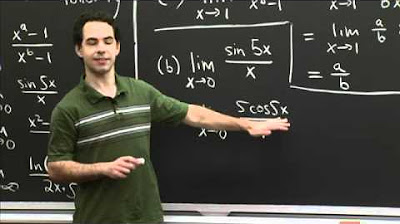Using L'Hopital's Rule on AP Calculus Exam FRQs
TLDRThe video script offers an insightful guide on applying L'Hôpital's rule to free response questions, a concept that has been featured in recent calculus exams. It emphasizes the importance of separately addressing the limits of the numerator and the denominator, justifying these limits, and correctly applying L'Hôpital's rule. The speaker provides a step-by-step approach, starting with understanding the function's differentiability and continuity to justify the limit's value. The script walks through several examples from past exams, illustrating how to handle indeterminate forms and the necessity of showing work, especially when differentiating functions to apply L'Hôpital's rule. The video aims to equip viewers with the skills to tackle such problems efficiently and accurately on free response sections of exams.
Takeaways
- 📚 **Separate Limits:** When applying L'Hôpital's rule on FRQs, handle the limits of the numerator and the denominator separately, not just as 'zero over zero' or 'infinity over infinity'.
- ✅ **Justify the Limit:** Ensure that the use of L'Hôpital's rule is justified. If you know the function, find the limit directly. If you know about the function, use differentiability and continuity to justify the limit.
- 📝 **Show Your Work:** Always write out the limits when using L'Hôpital's rule. Omitting this can lead to losing points.
- 🚫 **MC vs. FRQ:** On multiple-choice questions, you don't need to justify the use of L'Hôpital's rule as you would on FRQs.
- 🔢 **Evaluate Functions:** If you know the function, simply substitute the value to find the limit.
- 🔁 **Use Continuity:** If a function is differentiable, it is continuous, and the limit as x approaches a certain value is equal to the function's value at that point.
- 🔄 **Apply L'Hôpital's Rule:** When you have an indeterminate form, apply L'Hôpital's rule by differentiating the numerator and the denominator and re-evaluating the limit.
- 📉 **Evaluate Denominator:** For the denominator, establish that the limit as x approaches a certain value is zero or infinity based on the given information or the function's behavior.
- 📈 **Evaluate Numerator:** For the numerator, either directly evaluate the limit if the function is known or justify it using the properties of the function.
- 🔗 **Link Ideas:** When justifying, link the ideas of differentiability, continuity, and the value of the function at a certain point to establish the limit.
- 🧮 **Algebraic Solution:** After applying L'Hôpital's rule, solve the resulting algebraic expression to find the value of the limit.
Q & A
What is the primary focus of the video?
-The video focuses on how to use L'Hôpital's rule on free response questions, particularly those that require justification.
Why is it important to deal with the limits of the numerator and denominator separately when applying L'Hôpital's rule?
-Dealing with the limits separately ensures that you are not simply writing 'the limit equals zero over zero', but rather you are addressing the limit of the numerator and the limit of the denominator, which can be zero or infinity, before applying L'Hôpital's rule.
What is the significance of differentiability in justifying limits?
-Differentiability implies continuity, and continuity means that the limit as x approaches a certain value is equal to the value of the function at that point, which is crucial for justifying the limit in the context of the problem.
Why is it necessary to write the limits when using L'Hôpital's rule?
-Writing the limits is important because it shows the process of finding the limit and helps to avoid losing points for not showing the work in an exam or assessment.
What is the difference between applying L'Hôpital's rule on free response questions and multiple choice problems?
-On free response questions, you need to include justification and show your work, whereas on multiple choice problems, you can focus on solving the problem quickly and accurately without the need for detailed justification.
How does the video use the example from the 2018 exam to illustrate the application of L'Hôpital's rule?
-The video uses the example of a function f(x) = e^x*cos(x) and a differentiable function g(x) to find the limit as x approaches pi/2 of f(x)/g(x), illustrating the process of justifying the limit and applying L'Hôpital's rule step by step.
What is the role of the second fundamental theorem of calculus in the context of the 2021 exam example?
-The second fundamental theorem of calculus is used to establish that g'(x) = f(x), which is then used to connect the properties of f and g, allowing for the justification of the limit as x approaches 2 of g(x)/(x^2 - 2x).
How does the video approach the problem from the 2019 exam?
-The video approaches the problem by first establishing the continuity and differentiability of the functions f, g, and h, and then using the given information to justify the limit as x approaches 2 of h(x). It then uses this limit to find the values of f(2) and f'(2).
What is the key takeaway from the video regarding the application of L'Hôpital's rule?
-The key takeaway is the importance of understanding the conditions under which L'Hôpital's rule can be applied, the necessity of justifying the limit, and the process of showing your work clearly when applying the rule.
Why is it important to practice free response questions?
-Practicing free response questions helps to familiarize oneself with the process of justification and application of mathematical concepts like L'Hôpital's rule, which is essential for exams and assessments that require a deeper understanding and application of these concepts.
What is the common mistake to avoid when applying L'Hôpital's rule?
-A common mistake to avoid is not showing the limits when applying L'Hôpital's rule, as this can lead to losing points in an assessment for not demonstrating the work properly.
How does the video emphasize the importance of understanding the function's properties?
-The video emphasizes the importance of understanding the function's properties, such as differentiability and continuity, as these properties are key to justifying the limits and correctly applying L'Hôpital's rule.
Outlines
📚 Introduction to L'Hôpital's Rule in FRQs
This paragraph introduces the concept of L'Hôpital's rule within the context of free response questions (FRQs) for calculus exams. It emphasizes the importance of separately addressing the limits of the numerator and the denominator when dealing with indeterminate forms like 0/0 or ∞/∞. The paragraph also highlights the need for justifying the limit, which involves understanding the function's behavior and using properties like differentiability and continuity. Lastly, it stresses the correct application of L'Hôpital's rule and the necessity of including limit notation to avoid losing points.
📈 Applying L'Hôpital's Rule: Example from 2018 Exam
The second paragraph delves into an example from the 2018 exam, specifically part D, to illustrate the application of L'Hôpital's rule. It discusses a function f(x) = e^x cos(x) and a differentiable function g(x) with g(pi/2) = 0. The goal is to find the limit as x approaches pi/2 of f(x)/g(x). The paragraph explains how to use the differentiability of g(x) to establish the limit of the denominator and evaluates the limit of the numerator directly. It then justifies using L'Hôpital's rule and proceeds to find the derivatives f'(x) and g'(x), noting the importance of showing the work and including the limits in the solution.
🧮 Continuity and Differentiability in Limits: Example from 2021 Exam
This paragraph presents another example, this time from the 2021 exam, part C. It involves a continuous function f defined on the interval [-4, 6] and an accumulation function g(x) defined as the integral of f from 0 to x. The task is to find the limit as x approaches 2 of g(x)/(x^2 - 2x). The paragraph outlines the process of connecting the properties of f and g to establish the behavior of the limit. It uses the second fundamental theorem to relate g'(x) to f(x) and leverages the continuity of f to argue the differentiability and continuity of g. The example demonstrates evaluating the limit directly and then applying L'Hôpital's rule to find the limit of the derivative of g(x) over the derivative of the denominator, ultimately finding the value from the given graph of g'(x).
🔍 L'Hôpital's Rule and Justifying Limits: Example from 2019 Exam
The final paragraph discusses a complex problem from the 2019 exam, part C, involving twice differentiable functions f, g, and h with given values for g(2) and h(2). The challenge is to use the limit as x approaches 2 of h(x) to find f(2) and f'(2), despite not having explicit expressions for f(x) or h(x). The paragraph explains the iterative process of using differentiability and continuity to justify limits and apply L'Hôpital's rule. It demonstrates how to handle the reverse situation where L'Hôpital's rule is known to be applicable, and the limit is initially indeterminate. The solution involves finding f(2) by understanding the behavior of f as x approaches 2 and then using this information to apply L'Hôpital's rule and find f'(2), showcasing the interplay between differentiability, continuity, and L'Hôpital's rule in solving complex limit problems.
Mindmap
Keywords
💡L'Hôpital's Rule
💡Free Response Questions (FRQs)
💡Differentiability
💡Continuity
💡Indeterminate Forms
💡Derivatives
💡Limits
💡Justification
💡Product Rule
💡Chain Rule
💡Integral
Highlights
L'Hôpital's rule is an important concept for Free Response Questions (FRQs) in Calculus AB and BC.
When dealing with limits on FRQs, it is necessary to handle the limits of the numerator and denominator separately.
Justification of the limit is required, which involves understanding the function's differentiability and continuity.
If the function is known, the limit can be found by direct substitution.
If only information about the function is known, a combination of differentiability and continuity must be used to justify the limit.
L'Hôpital's rule should be applied correctly, ensuring that limits are written and shown in the process.
For multiple-choice problems, the justification process is not required, and problems should be solved quickly and accurately.
The video provides examples from 2018, 2019, and 2021 exams, indicating the importance of L'Hôpital's rule in recent FRQs.
Differentiability of a function implies continuity, which is a key concept used to justify limits.
The limit of a function as x approaches a certain value can be found by evaluating the function at that value if the function is known.
When applying L'Hôpital's rule, it is crucial to avoid indeterminate forms and find a determinate answer.
The video demonstrates how to find the derivative of a function using the product rule and how to apply it to L'Hôpital's rule.
The Fundamental Theorem of Calculus is used to connect the derivative of an integral function to the original function.
The video emphasizes the importance of showing work and providing a step-by-step justification when using L'Hôpital's rule.
In some cases, the value of a function or its derivative at a certain point is needed to solve the problem, which requires a deeper understanding of the function's behavior.
The Chain Rule is used to find the derivative of composite functions, which is essential for applying L'Hôpital's rule.
The video concludes by stressing the need to practice FRQs to become familiar with the process of using L'Hôpital's rule and justifying limits.
Transcripts
Browse More Related Video

Using L'Hopital's Rule to show that exponentials dominate polynomials

l'Hospital Practice | MIT 18.01SC Single Variable Calculus, Fall 2010

Business Calculus - Math 1329 - Section 3.3 - Curve Sketching

L'Hopital's Rule (Other Indeterminate Forms)

Calculus Chapter 1 Lecture 8 l'Hopital's Rule

2021 Live Review 3 | AP Calculus AB | How to Find Limits & Continuity
5.0 / 5 (0 votes)
Thanks for rating: